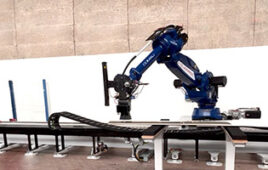As the Internet of Things (IoT) gains traction, more companies will declare support for various product offerings. One product that is gaining supporters is Windows 10 from Microsoft. According to Microsoft, Windows 10 IoT will power a range of intelligent connected devices from smaller equipment, such as gateways or mobile point-of-sale units, to industrial devices, like robots and specialty medical equipment.
Designed to connect through the Microsoft Azure IoT services, Windows 10 IoT offers enterprise-grade security along with native connectivity for machine-to-machine and machine-to-cloud scenarios.

Azure IoT Suite is an integrated offering that takes advantage of all relevant Azure capabilities to connect devices and other assets, capture the diverse and voluminous data they generate, integrate and orchestrate the flow of that data, and manage, analyze and present it as usable information. The offering, while customizable to fit the unique needs of organizations, will also provide finished applications to speed deployment of common scenarios seen across many industries, such as remote monitoring, asset management and predictive maintenance, while providing the ability to grow and scale solutions to cover millions of “things.”
Within proprietary Windows 10 IoT networks, establishing communication is done with AllJoyn. AllJoyn is an open source software framework and set of services for interoperability among connected devices, regardless of the underlying proprietary technology of communication protocol. By implementing AllJoyn in Windows 10, Microsoft is joining with more than 80 alliance members to support interoperability across a variety of platforms and at scale, advancing the development and vision of the IoT.
New Feature Highlights
- Cortana—Microsoft’s virtual assistant, which has been present on its phone operating system for a while now, is accessible directly from the desktop with either a click or voice command. It can serve as a handy helper when you need to get things done.
- Microsoft Edge—Edge is slated to become the new default web browser for Windows 10, with Internet Explorer consigned to the background to support legacy software. Edge features a host of built-in features such as a screen grab tool with touchscreen doodling ability, a note pad and reading mode.
- Virtual desktops—A key tweak has been made to one of the most important features of Windows 10, as far as desktop users are concerned, which is virtual desktops. On previous builds, the apps you had open on any desktop where shown on every desktops taskbar, making it cluttered. No so with Windows 10.
- Task View for multi-tasking—This feature makes multi-tasking more useful. Sitting on the taskbar across the bottom of the screen, when launched, it will display all of your currently opened apps.
- Multiple desktops—When you launch Task View, Windows 10 will support the ability to view multiple desktops. You can switch between different desktops where multiple apps run. Using the “Snap Assist” feature, you will also be able to grab apps from those different desktops.
Advantech offers diverse platforms with Windows 10 IoT pre-installed, including boards, systems and gateways. A WISE-PaaS platform fully supports Windows 10 IoT with core, mobile and industry versions through the Universal Windows Apps structure to offer Cloud services. By adopting it, developers can rapidly build and deploy applications with greater speed, flexibility and agility. It enables developers to easily and effectively construct IoT Cloud solutions.
Advantech Corporation, Industrial Automation Group
www.advantech.com/ea
Filed Under: IoT • IIoT • Internet of things • Industry 4.0, CONNECTIVITY • fieldbuses • networks, Robotics • robotic grippers • end effectors





Tell Us What You Think!